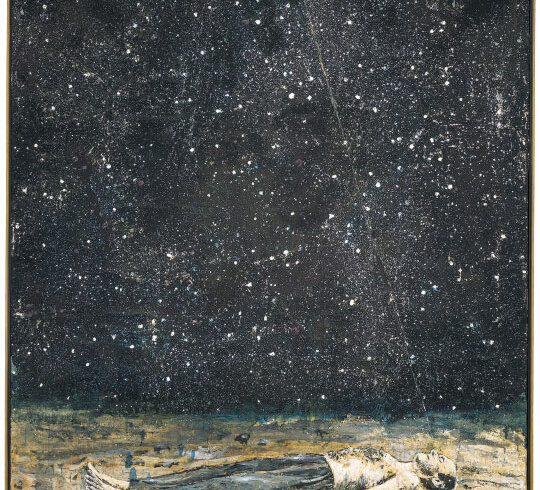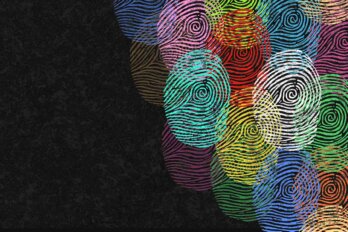On a frigid December morning a decade ago, I wandered through the narrow streets of the old town in Vilnius, Lithuania, with the low, steel-grey sky spitting snow, the air smelling of the coal still used in the furnaces, looking for Lithuania’s Jewish museum. Although Vilnius had once been an important centre of Jewish learning, virtually every trace of that culture—its buildings, its books, its people—was erased by the German army during World War II. After a long search, I came upon what turned out to be the temporary location of the museum: a drab, poorly lit house just outside the old city, run by a pair of frail, elderly, and fiercely bitter sisters. Its collection catalogued Nazi atrocities in Vilnius and the nearby city of Kaunas, and mostly consisted of faded copies of documents and unframed photographs pinned to the walls. Encased in glass along one wall, however, were several fire-damaged Torah scrolls. They were blackened, their leather split open and twisted into wild shapes, and in places I could detect smears of the ink from the original Hebrew lettering.
There is something especially melancholic about ruined Torah scrolls, and ruined books in general—they represent the destruction of a civilization. Traditionally, the Torah is the link between heaven and earth, between the human and the divine, and when one is marred, even slightly, that link is permanently broken.
I immediately thought of those scrolls in Vilnius when I encountered Anselm Kiefer’s Meteorites (1998/2005) in the exhibition Heaven and Earth at the Musée d’art contemporain de Montréal, the first major North American survey of the German artist’s work since a retrospective that toured the United States from 1987 to 1989. Meteorites is a three-metre-high steel bookcase housing massive lead tomes, their warped and twisted pages interspersed with rough stones that tumble out onto the floor. While Meteorites undoubtedly alludes to the Holocaust and the destruction of Germany during the Second World War, Kiefer’s ambition goes beyond simply acknowledging the crimes of the Nazi era. The stupendous scale and weight of the books makes it clear that they are not addressed to humans, but to giants or gods or simply the sky. Other monumental, sculptural books in the exhibition include Book with Wings (1992-94), an open lead book set on a high lectern with ragged lead and tin wings spreading out from its sides, and 20 Years of Solitude (1971-91), five pallets of crinkled, oxidized sheets of lead on top of which are books spattered with twenty years’ worth of the artist’s dry, yellow semen. Both suggest that these are not only works of ruin and mourning, but also of regeneration.
Born in Donaueschingen in southwest Germany in 1945, a few months before the end of the war, Anselm Kiefer was the child of a devastated country. He initially studied law in Freiburg but changed over to art after a transformative stay at Sainte Marie de La Tourette, the French Dominican monastery designed by Le Corbusier. He is now living and working in the south of France. Kiefer rose to prominence in the 1980s alongside “neo-expressionist” painters such as Georg Baselitz and Jörg Immendorff. Whereas the work of these latter-day German expressionists often relied on the cliché of the German soul tortured with guilt over the crimes committed under the Third Reich, Kiefer’s art is metaphysical rather than psychological, falling into the romantic, symbolist tradition of the painter Caspar David Friedrich and the composer Richard Wagner. Kiefer has said that he has always wanted to deal with large issues in his art and he has succeeded: his work is vast in scale, in theme, and in emotional impact.
Anselm Kiefer is a postwar artist by birth and temperament, and of his generation he may be the most attuned to the unprecedented conditions in Germany in the years immediately following the war. In his essay “Air War and Literature,” the novelist W. G. Sebald writes:
[O]f the 131 towns and cities attacked, some only once and some repeatedly, many were almost entirely flattened, that about 600,000 German civilians fell victim to the air raids, and that three and a half million homes were destroyed, while at the end of the war seven and a half million people were left homeless, and there were 31.1 cubic meters of rubble for every person in Cologne and 42.8 cubic meters for every inhabitant of Dresden—but we do not grasp what it all actually meant.
It is difficult for us to even imagine life in those cities—the mountains of rubble, the stench of decaying corpses, the clouds of flies and the armies of rats, the dazed, half-starved survivors camping out on the ruins. The destruction and trauma brought about by the area bombings of German cities in the last years of the war appear to have given rise to a strange form of amnesia. Upon returning from exile in 1945 to a town in southwest Germany, for instance, novelist Alfred Döblin wrote that people walked “down the street and past the dreadful ruins, as if nothing had happened, and the town had always looked like that.” The psychologists Alexander and Margarete Mitscherlich published a study of this phenomenon in 1967 and regarded it as a collective “inability to mourn.”
It is this need for mourning and communal melancholy, which according to the Mitscherlichs Germans could not psychologically confront, that forms the deep background of Kiefer’s work. And for Kiefer the only way to approach this is to return to the kind of primordial, mythic history familiar from Wagner’s Der Ring des Nibelungen cycle. “Our stories always begin in the forest,” Kiefer has said, and indeed the forest is crucial to both German history and mythology. It is part of the resonance of the great tree with a sword embedded in it that serves as the central image of Die Walküre, the Ring’s second opera.
In one of the earliest paintings included in Heaven and Earth, Man in the Forest (1971), the artist stands in a loose nightshirt holding a burning branch, surrounded by the narrow trunks of soaring pines. Clearly a dream image, the figure is dwarfed by the trees. He is small, barefoot, and helpless, and yet he has an aggressive air—he seems to be competing with, even threatening, the giants that surround him. Man in the Forest is an ambivalent allegory of the power of the imagination to invent and also to destroy, a reminder that power is always seductive and dangerous.
In Resurrexit (1973), a snake takes on the point of view of the artist, slithering up from the lower edge of the canvas into a road through a forest in late autumn under a fierce cerulean sky. Above is a pyramidal shape that replicates the stairway into the attic studio Kiefer occupied in Hornbach, a village near the Black Forest. In this painting, the studio is depicted as a heavenly realm but the artist himself is a demonic figure. In another painting from 1973, Quaternity, the studio appears again; three fires burn on its intricately rendered wooden floor as a snake enters their orbit. The conflagrations are named Vater (Father), Sohn (Son), and hl. Geist (Holy Spirit) respectively, and above the serpent is the word Satan. For Kiefer, the imagination, the places where it is given freedom, and the materials upon which it works, are at once volatile, conflicted, and demonic. Fire is, after all, a symbol of the spirit, an alchemist’s tool, and a basic element; it is also fire that reduced cities like Hamburg and Dresden to heaps of smoking rubble.
Through the 1970s, Kiefer continued to explore the relationship between the artist and the natural world. In Heaven—Earth (1974), a tree curls up the left-hand side of the canvas, and under the tree’s branches is an outline of a painter’s palette, framing a traditional landscape. Within the palette is a vertical axis along which are scrawled Himmel (heaven), malen (painting), and Erde (earth). As in Wagner, the tree is a symbol of archaic origins and power but the palette, and the vertical line, seem tentative, uncertain of the real relationship between heaven and art and earth. Painting of the Scorched Earth (1974) has a similar composition, with a tree and a palette, but it opens out onto a blackened and smouldering landscape—suggesting that the fires of war spoiled the landscape in which nineteenth-century romantic painters found inspiration, then compromised the purity of that relationship to nature.
The scorched earth in these paintings also appears in some of Kiefer’s gorgeous early book projects. Cauterization of the Rural District of Buchen (1975) is a sixty-page book; to produce it, Kiefer burned his own paintings and then cut them down to neat, oily, black pages. Cauterization implies that the destruction of Germany, the burning of its flesh, was necessary in order to renew it. “Collective catastrophe marks the point where history threatens to revert to natural history,” Sebald writes in his essay “Between History and Natural History.” “In the midst of the ruined civilization, what life is left assembles to begin at the beginning again in a different time.” For Kiefer, the distinction between natural history and mythic history, between the flow of matter and the flow of spirit, between heaven and earth, is hopelessly blurred.
By the 1980s, Kiefer’s work had become grander, more unabashedly sensuous, and more elegiac. In The Milky Way (1985-87), the beholder, diminutive in front of the massive canvas, seems to be gliding fast and low over a thick, fleshy pink-and-gold field that pales as it recedes into a burning horizon. Like the preludes and interludes of Wagner’s Ring, where the music seems less an illustration of a story than a physical enactment of the processes of fate, the surfaces of Kiefer’s paintings are not so much illusions as the cascading and active nexus of natural forces. There is a cut in the foreground of the canvas, a white gash in which Kiefer has written die Milchstrasse (the Milky Way), and pointing into that cut is a lead funnel rigged by wires to the top of the painting.
The landscape in The Milky Way is both apocalyptic and sumptuous, a despoiled promised land of milk and honey and fire. The lead funnel could easily be a mysterious object rescued from the rubble of a destroyed city (” This state began with a nation rummaging in the refuse,” novelist Heinrich Böll said of West Germany), but it could also be a magical instrument used to anneal the rift between heaven and earth—or both. The lead from which the funnel was made, the lead that appears so frequently in Kiefer’s work, is a powerfully symbolic material. It is the materia prima of the alchemist’s esoteric trade, the material that streamed from rooftops during the firestorms in Dresden, and the material out of which the movable type in the old Jewish printing presses of Vilnius was made and which, according to legend, was later melted down into bullets by resistance fighters.
The Hierarchy of Angels (1985-87) is an aerial view, soaring over a grid of fields that swim with dark, molten blues and blacks. The horizon is a foaming seascape, white waves and black water, and the sky is smeared with burnished gold. Tilted across the centre of this huge canvas is an airplane propeller fashioned from sheets of lead and craggy chunks of metal named after various seraphim and cherubim. The propeller draws the viewer into the point of view of a bomber bearing down on a landscape, but it could also represent the whirling universe, and the chunks of lead could be lost angels, avenging angels, bombs, or mere debris. Kiefer’s art is emotionally disorienting in part because catastrophe and redemption are so closely intertwined and ultimately unresolved.
Kiefer’s more recent work, though not exactly lighter, is less oppressed by the weight of the past and has an almost Byzantine luxuriance. The Heavenly Palaces (2002) consists of a long view down a corridor between heavy golden pillars as the heavens, speckled white and lead-grey, come crashing down through the roof. In Sefer Hechaloth (2002), named after an ancient mystical Hebrew text mapping the ascent of the spirit to the palaces of God, shelves jut out from a blue-grey ground, forming a jagged staircase, and on each step is a burned book, as though destruction, or purification, by fire were a precondition of transcendence.
Paintings like the 2004 version of The Heavenly Palaces are full of longing that is at once carnal and spiritual. The ground is a fluid grey shot through with gold, and it flows back to a flat horizon. Above are old, rusty birdcages, and in some of them rest stones. These are closed, battered palaces, and what they contain is finally impenetrable. Melancholia (2004), on the other hand, is nearly classical in style. Above a stormy sea, shimmering with gold, hangs a glass polyhedron, hermetic symbol of the philosopher’s stone that appears in Albrecht Dürer’s 1514 masterpiece of the same title. In Kiefer’s work, the instruments imposed on a landscape—perspective line, painter’s palette, finely carpentered polyhedron—stand in for the mind’s effort to grasp the vastness and flux of the natural world. And the mind is inevitably dwarfed, inundated, and powerless. According to eighteenth-century philosopher Immanuel Kant, an experience of the natural sublime occurs when the imagination cannot encompass the infinity of nature. But Kiefer’s work is less about an oceanic feeling of the sublime than it is about knowledge and consciousness.
Anselm Kiefer’s art is beautiful, and ugly, and punishing, and exhausting, and, at moments, sublime. After viewing Heaven and Earth last February, on a day as bitterly cold as the one I spent in Vilnius, I took a break by watching a short video documenting the unloading and installation of Ash Flower (1983-97) in Montreal. The painting reproduces the interior perspective of a Nazi ceremonial hall designed by Hitler’s chief architect, Albert Speer. It is smeared over with layer after layer of ash. Attached to the centre of the painting, upside down, is an immense dried sunflower, clods of dirt sticking to its roots. Workers carefully slid the enormous wooden crate from the back of a truck in the midst of an intense blizzard that filled the screen with a swarm of white. Inside the museum, the installers opened the crates and lifted the fragile panels as though they were sacred relics. Anxious curators looked on. Watching the video, I thought not of the ruined Torah scrolls in Vilnius or of the Holocaust, but of Germany itself. Outside once shattered but now immaculately restored buildings in cities like Hamburg, Nuremberg, and Cologne, one often finds plaques that say “Destroyed: April 1944/ Restored: June 1966,” sometimes accompanied by a photograph of the building taken shortly after the bombing, as though the war had occurred in order to demonstrate the efficiency of German construction crews.
This may be just another expression of the “inability to mourn,” but Germany remains haunted by the ghosts of its own destruction, and in a larger sense so do we. In his “Theses on the Philosophy of History,” compiled in 1940, the same year he committed suicide while fleeing the Nazi invasion of France, Walter Benjamin wrote: “This is how one pictures the angel of history. His face is turned toward the past. Where we perceive a chain of events, he sees one single catastrophe which keeps piling wreckage upon wreckage and hurls it in front of his feet.”
We in North America are perhaps made nervous by the scale and ambition of an art like that of Anselm Kiefer, or of Richard Wagner for that matter. We are often more comfortable with an aesthetic that addresses easily grasped issues with precision and critical clarity—an efficient, bureaucratic art that has relinquished the wild nineteenth-century ambitions of Hegel, Marx, and Wagner. We are fussy; we have chronically cold feet. Yet the fact that Heaven and Earth travelled (at great expense, no doubt) to Montreal, and that the complete Ring cycle will open the new Toronto opera house this fall, suggests that we long for something deeper. Perhaps we sense that the catastrophe of history is piling up at our feet too, and we need a language to understand it; perhaps we too suffer from an inability to mourn and need to be awoken; perhaps we need an art that is larger and more harrowing. Vaulted halls encrusted with ashes, palaces with the heavens crashing through, Wotan lamenting the decline of the gods, Valhalla engulfed in flames.






